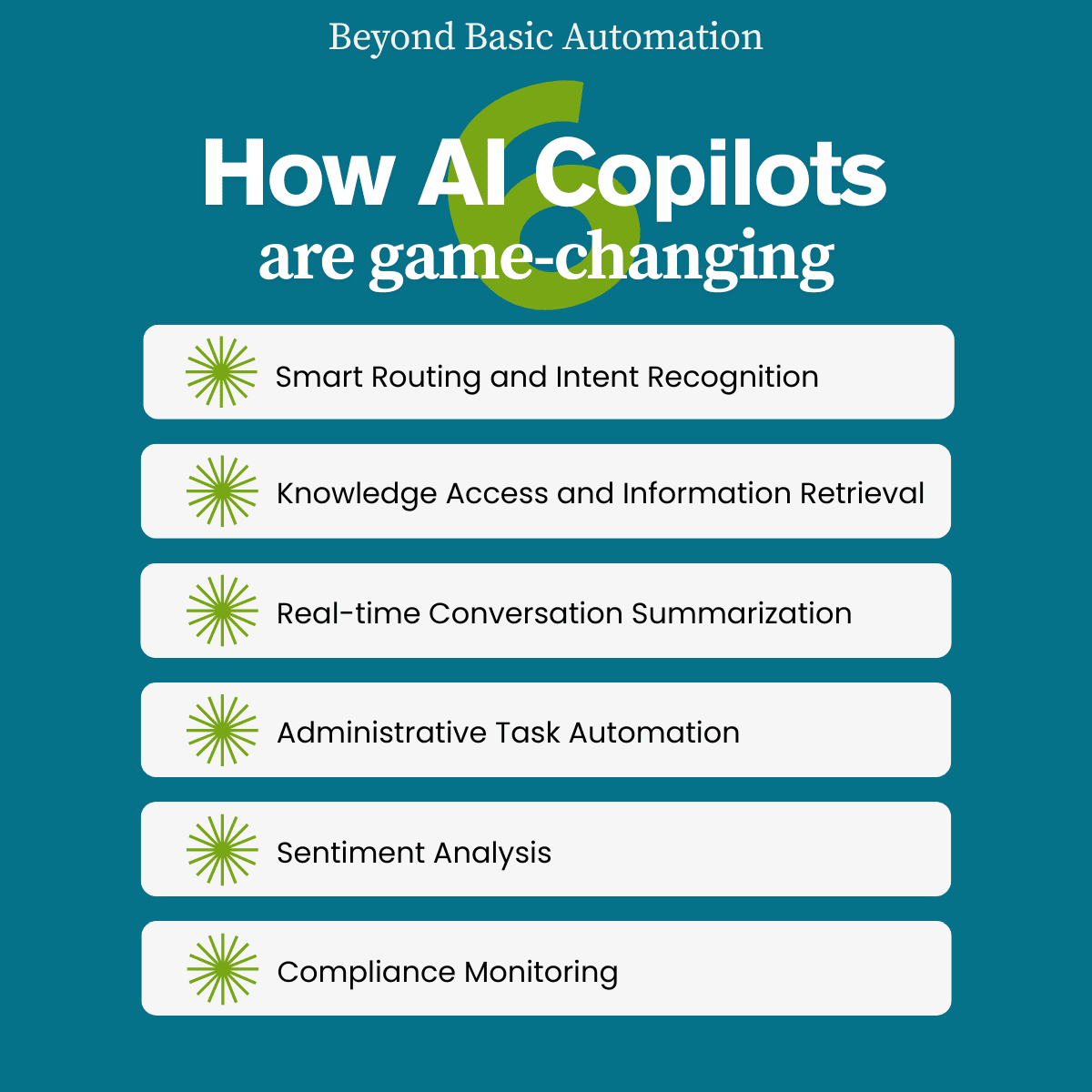AI, Customer Service Transformation, Large Language Model, Voice
The Game-changing Characteristics of AI Copilots for Customer Service
Taking Customer Experience to the Next Level with AI Copilots for Customer Service
Good customer service is often a means for a company to stand out amongst its competitors, build loyalty, and retain customers. However, with over 80% of organizations (according to a recent Gartner survey) expecting to compete mainly based on customer experience, why are customers often far from satisfied by the support they receive?
Providing excellent customer service is far from easy. Agents are often overwhelmed, undertrained, and don’t necessarily have enough information to resolve a customer issue quickly and easily. At the same time, customer expectations are increasingly demanding on accuracy, immediacy and empathy. Fear not, however. The recent emergence and adoption of generative AI and large language models (LLMs) in customer service and contact center operations, are fueling a new paradigm for superior customer experience.
Enter AI copilots—sophisticated AI assistants that are revolutionizing how customer service teams operate. These intelligent systems don’t replace human agents but rather collaborate with them to enhance their capabilities. It’s the perfect harmony between human intelligence, empathy and emotion and the task efficiency, intelligence, and data insights provided by generative AI and Large Language Models (LLMs).
What are AI Copilots Powered by LLMs?
AI copilots are AI-powered assistants that help customer service agents by automating different process tasks, making agents more efficient and arming them with the relevant information they need in real time. LLMs (such as GPT 4, Claude, BERT, LamBDA, and others) enable these copilots to understand, generate, and process natural language, offering contextualized, human-like responses during customer interactions. Instead of replacing agents, these AI copilots augment their capabilities by handling repetitive tasks, retrieving information, and providing real-time support, allowing agents to focus on higher-level problem-solving and customer interactions.
What Makes AI Copilots Game-Changers?
- Omnichannel Presence, including:
Voice: In real-time voice conversations, copilots can transcribe, analyze sentiment, and suggest responses to agents.
Web and Messaging: In web chats or messaging platforms, AI copilots can autonomously handle basic customer queries, escalate complex ones, and provide real-time summaries to human agents.
Email: Intent scanning, response generation, and automatic handling of straightforward requests
- Smart Routing and Intent Recognition: Copilots can instantly identify customer needs and direct them to the right resource or specialist—first time.
- Knowledge Access and Information Retrieval: Copilots can search vast knowledge bases in milliseconds to provide agents with accurate information.
- Generate Real-time Conversation Summaries: LLMs can automatically summarize long chat or call transcripts, offering agents highlights or key points, reducing the time spent reviewing previous conversation history.
- Administrative Task Automation: Handling documentation, verification, and system updates, for example
Document capture and verification: Automating document handling tasks like ID verification or capturing required forms.
Payment processing: Automating payment collections or transaction processing in the course of customer service interactions.
Performing administrative tasks such as generating post-call notes and summaries, documenting follow up actions, and updating customer records in backend systems of record or CRMs.
- Anomaly Detection: AI Copilots can identify unusual patterns in customer behavior or account activity in real time, flagging potential issues.
- Customer Sentiment Analysis: By evaluating the tone and emotion behind customer interactions, AI copilots can determine whether a customer is frustrated, satisfied, or neutral and suggest next steps.. This helps agents tailor their responses to the customer’s emotional state.
- Compliance Monitoring: AI copilots can also ensure that conversations or transactions follow necessary regulations, reducing legal risks. Compliance checks can be made on agent responses or conversation histories, allowing potential compliance issues to be flagged to the agent.
Measuring the ROI of AI Copilots
The business impact of AI copilots can be measured across several critical dimensions:
Operational Efficiency
- Reduced Average Handle Time (AHT): By automating routine tasks and providing instant information access
- Improved First-Call Resolution (FCR): Through better routing and comprehensive agent support
- Enhanced Scalability: Meeting demand fluctuations without proportional staffing increases
Customer Experience Enhancement
- Faster Response Times: Immediate assistance across all channels
- Consistency in Service: Standardized quality regardless of channel or agent
- Personalization at Scale: Tailored interactions based on customer history and preferences
Agent Empowerment
- Reduced Cognitive Load: Eliminating repetitive tasks and information searching
- Improved Confidence: Real-time guidance and suggestions
- Focus on Complex Tasks: Allowing human agents to concentrate on high-value interactions
Implementation Best Practices
For organizations looking to adopt AI copilots in their customer service operations:
- Start with Clear and Easy Use Cases: Identify specific pain points where AI can drive immediate value
- Focus on Integration: Ensure seamless connectivity with existing systems and workflows
- Prioritize Agent Adoption: Involve frontline staff in implementation planning, testing, and provide comprehensive training
- Measure and Iterate: Establish clear metrics and continuously refine the system based on results
- Balance Automation and Human Touch: Use AI for efficiency but preserve human connections for complex or emotional issues
The Future of AI Copilots in Customer Service
As AI technology continues to evolve, we can expect AI copilots to become even more sophisticated:
- Predictive Service: Anticipating customer needs before they arise
- Deeper Personalization: Tailoring responses based on comprehensive customer understanding
- Enhanced Emotional Intelligence: More nuanced detection and response to customer sentiment
- Expanded Autonomy: Handling increasingly complex interactions independently
By embracing AI copilots today, customer service organizations aren’t just preparing for the future—they’re creating it, delivering exceptional experiences while optimizing operational performance in ways that were previously impossible.
Read more about the Role of AI assistants, Copilots and Agentic AI
Download the eBook: Business Use Cases for Generative AI and LLMs
If you’d like to discover more about what generative AI can do to your business outcomes, please contact us.

